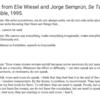6: Text excerpt from Elie Wiesel and Jorge Semprún's "Se taire est impossible," 1995, and audio clip from Elie Wiesel's lecture "From Holocaust to Rebirth," 1970.
Holocaust survivors frequently talk about the responsibility to “bear witness.” Yet, just as often, they reference the difficulty or impossibility of speaking about their experiences in the Holocaust. This activity focuses on how survivors perceive the task of testifying to their Holocaust experiences. Jorge Semprún is a concentration camp survivor best known for his memoir L’écriture ou la vie (Literature or Life), 1994.
Suggested Activity: As a warm-up, ask students to consider the reasons why someone might choose to bear witness to a catastrophic experience. Write this list of possible reasons on the board (e.g., personal responsibility, religious imperative, psychological release). Then give students this excerpt from Se taire est impossible, and play the audio excerpt from Wiesel's 1970 lecture. Ask the students: according to Wiesel and Semprún, what are their reasons for writing about their experiences? What do they mean when they say that “speech is impossible”? Are there aspects of the Holocaust, or of life in general, that are “unspeakable”? If yes, how so? What does “unspeakable” or “impossible” mean in this context?
Sources: Elie Wiesel and Jorge Semprún, Se taire est impossible (Paris: Gallimard, 1995), 17, 36-37. Unpublished translation by Charlotte F. Werbe.
Elie Wiesel, "From Holocaust to Rebirth," (Lecture, Montreal Jewish Public Library, November 14, 1970).

